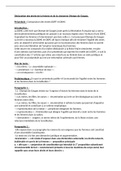Behavioural Finance Topic 9 – Intertemporal Choices and Choice Architecture
Intertemporal Choices
What we will be looking at this session
Intended Learning Objectives
By the end of this session students should be able to:
• Describe the classical discounted utility model (the DUM) and show that it leads to time
consistent choices
• Define present-moment bias and identify and describe the principal anomaly in the DUM
• Describe the form of hyperbolic discounted utility models and show how they can explain time
inconsistent choices
• Explain how present moment bias and hyperbolic discounting lead to procrastination and the
failure of many people to save enough for retirement
• List the three types of ‘hyperbolic discounters’
• Give examples of inter-temporal choices that are not explained by either the DUM or
hyperbolic discounting
Why does the way we discount things matter?
• We behave in ways that are bad for us individually and for society as a whole (e.g.
overeating, smoking, substance abuse, unsafe sex)
• We rely on unsustainable sources of energy
• We damage and pollute the environment
• We don’t save enough for retirement
All involve myopic tradeoffs between immediate and future costs and benefits.
The Discounted Utility Model*
• Expected utility analogous to “Expected Value”
• Discounted utility model analogous to discounted cash-flow approach (Net Present Value)
• U(Ct) can be viewed as person’s instantaneous utility consumption function at times t
• D(t) defines the person’s discount function
• r is the rate the person discounts future utilities
• Functions such as
• And
* Samuelson, 1937.
Some features of the discounted utility model
• Exponential discounting
• Same discount rate used throughout
• When used in NPV calculations it is used to look at opportunity costs of investing/spending
money at different times
, • When used as temporal utility function it is intended for looking at temporal consumption
indifference values
Discount function D(t)
Discount rate (r) per period 25%.
Present and future indifference utility values
• Someone with this temporal utility function is indifferent to consumption with instantaneous
utility of 100 today and consumption with utility of 125 deferred one year
Time preferences under exponential discounting
• Choose between U(C1) = 1,000 in two years and U(C2) of 1,500 in three years
• U under DUP at time t = 0, r = 25%
Intertemporal Choices
What we will be looking at this session
Intended Learning Objectives
By the end of this session students should be able to:
• Describe the classical discounted utility model (the DUM) and show that it leads to time
consistent choices
• Define present-moment bias and identify and describe the principal anomaly in the DUM
• Describe the form of hyperbolic discounted utility models and show how they can explain time
inconsistent choices
• Explain how present moment bias and hyperbolic discounting lead to procrastination and the
failure of many people to save enough for retirement
• List the three types of ‘hyperbolic discounters’
• Give examples of inter-temporal choices that are not explained by either the DUM or
hyperbolic discounting
Why does the way we discount things matter?
• We behave in ways that are bad for us individually and for society as a whole (e.g.
overeating, smoking, substance abuse, unsafe sex)
• We rely on unsustainable sources of energy
• We damage and pollute the environment
• We don’t save enough for retirement
All involve myopic tradeoffs between immediate and future costs and benefits.
The Discounted Utility Model*
• Expected utility analogous to “Expected Value”
• Discounted utility model analogous to discounted cash-flow approach (Net Present Value)
• U(Ct) can be viewed as person’s instantaneous utility consumption function at times t
• D(t) defines the person’s discount function
• r is the rate the person discounts future utilities
• Functions such as
• And
* Samuelson, 1937.
Some features of the discounted utility model
• Exponential discounting
• Same discount rate used throughout
• When used in NPV calculations it is used to look at opportunity costs of investing/spending
money at different times
, • When used as temporal utility function it is intended for looking at temporal consumption
indifference values
Discount function D(t)
Discount rate (r) per period 25%.
Present and future indifference utility values
• Someone with this temporal utility function is indifferent to consumption with instantaneous
utility of 100 today and consumption with utility of 125 deferred one year
Time preferences under exponential discounting
• Choose between U(C1) = 1,000 in two years and U(C2) of 1,500 in three years
• U under DUP at time t = 0, r = 25%











